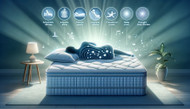Sleep Disorders 101: Types, Causes, and How the Right Mattress Can Help
Posted by Abe I on 8th Sep 2023
Sleep is a vital component of our daily routine, impacting our physical health, mental well-being, and overall quality of life. However, for many, a good night’s sleep is not easy to come by due to various sleep disorders. Understanding the types of sleep disorders, their causes, and how the right mattress can make a significant difference is the first step towards improving sleep quality. Here’s a comprehensive guide on sleep disorders and the role of mattresses in alleviating their symptoms.
Common Sleep Disorders
- Insomnia: The most prevalent sleep disorder, characterized by difficulty falling or staying asleep. Causes include stress, anxiety, medications, and underlying health conditions.
- Sleep Apnea: A serious condition where breathing stops and starts during sleep, often due to obstructed airways. Common signs include loud snoring, gasping for air during sleep, and feeling tired despite a full night’s sleep.
- Restless Leg Syndrome (RLS): This disorder causes an uncontrollable urge to move the legs, often due to uncomfortable sensations. It typically occurs in the evening or during periods of inactivity, making it difficult to fall asleep.
- Narcolepsy: A chronic sleep disorder characterized by overwhelming daytime drowsiness and sudden attacks of sleep at inappropriate times.
Causes of Sleep Disorders
Sleep disorders can arise from various factors, including genetics, neurological imbalances, psychological issues, environmental changes, and lifestyle habits. For instance, insomnia can be triggered by stress and anxiety, while sleep apnea is often linked to obesity and the anatomical structure of the mouth and throat.
The Role of Mattresses in Alleviating Sleep Disorders
A suitable mattress plays a crucial role in addressing sleep disorders by providing the necessary support and comfort to encourage better sleep patterns. Here's how the right mattress choice can help with common sleep disorders:
- For Insomnia: A comfortable mattress that aligns with your preferred sleeping position can reduce the time it takes to fall asleep. Memory foam mattresses, for instance, adapt to your body shape, providing a comforting, enveloping feel that may ease anxiety and promote relaxation.
- For Restless Leg Syndrome: Mattresses that offer good pressure relief can alleviate discomfort in the legs. Look for options with gel-infused foam or individually wrapped coils that reduce motion transfer and provide targeted support.
- For Narcolepsy: While mattress choice may not directly impact narcolepsy, ensuring optimal comfort and support can help maximize the quality of sleep, making it easier to manage daytime symptoms.
- For Sleep Apnea: People with sleep apnea may benefit from adjustable beds that allow elevation of the head. This position helps keep airways open, reducing the frequency of breathing interruptions.
Choosing the Right Mattress
Selecting the right mattress depends on individual preferences, body type, and specific health conditions. Consider factors such as firmness level, material, and support when choosing a mattress. Consulting with healthcare providers and sleep specialists can also provide personalized recommendations based on your sleep disorders.
Conclusion
Sleep disorders can significantly impact one’s quality of life, but understanding the types, causes, and finding the right mattress can help alleviate symptoms and improve sleep quality. If you’re struggling with sleep issues, consider evaluating your mattress as part of your strategy to achieve better sleep health.
For more detailed information on sleep disorders and recommendations on choosing the right mattress, reputable sources like the American Sleep Association and the Sleep Foundation offer valuable insights and guidance.

